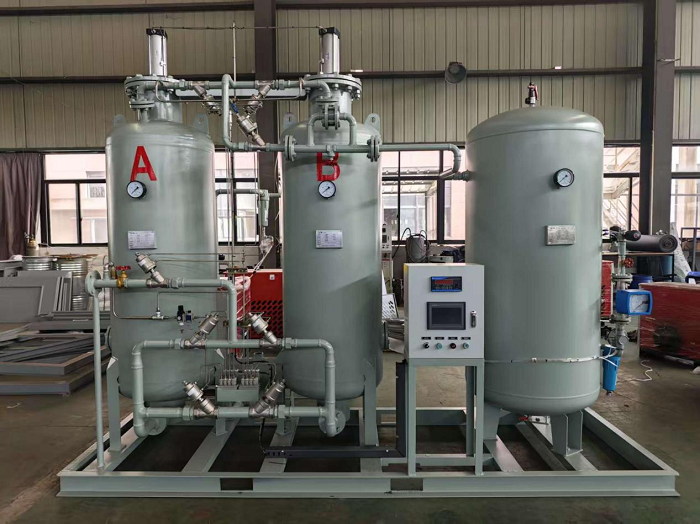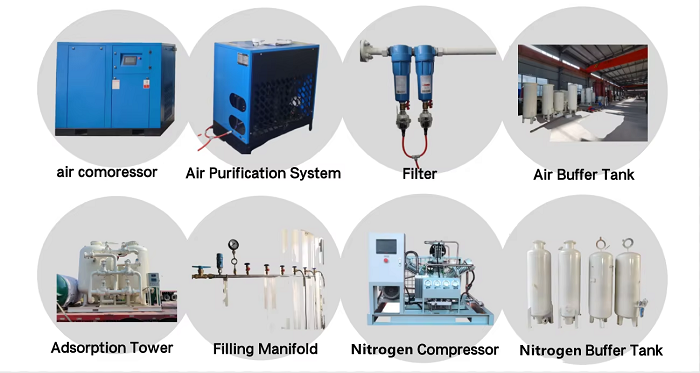Nitrogen generators are indispensable in industries ranging from food packaging (to preserve freshness) and electronics (to prevent component oxidation) to pharmaceuticals (to maintain sterile environments). Yet, high pressure during their operation is a prevalent problem that requires prompt intervention. Beyond disrupting production schedules, sustained high pressure poses severe risks: it can warp or crack critical components like stainless steel air tanks, cause pressure gauges to malfunction, and even lead to explosive leaks if the system’s pressure tolerance is exceeded. These issues not only result in costly downtime—with some factories losing thousands of dollars per hour of halted production—but also raise safety hazards for on-site workers, who may face risks of equipment-related injuries.
Several key factors contribute to high pressure in nitrogen generators. First, clogged filters are a primary culprit: pre-filters (designed to trap dust and debris) often get blocked by airborne particles over time, while carbon filters (used to remove oil vapors) can become saturated with grease, both restricting airflow and forcing the system to accumulate excess pressure. Second, a malfunctioning pressure relief valve—the system’s “safety valve”—may seize up due to dirt buildup or wear from long-term use, failing to release pressure when it exceeds the set threshold. Third, incorrect load settings create an imbalance: if the generator’s nitrogen output is set lower than its actual gas production rate, unused nitrogen accumulates in the storage tank, driving up internal pressure. Additionally, hidden leaks in the gas pipeline (such as small cracks at joint connections) can trick the generator into overproducing nitrogen to meet the perceived demand, indirectly causing sudden pressure spikes.
To address high pressure effectively, follow a step-by-step troubleshooting process while adhering to safety protocols (e.g., wearing protective gloves and goggles). Start by checking filters: shut down the generator, disconnect the filter housing, and inspect each filter—pre-filters with visible dust clumps or discoloration should be replaced immediately, while saturated carbon filters will emit a faint oil odor and require swapping with compatible replacements. Next, test the pressure relief valve: locate the valve (usually marked with a “pressure release” label), gently pull the manual release lever, and listen for a steady hiss of escaping gas; if the airflow is weak or inconsistent, clean the valve’s internal components with a non-corrosive solvent (like isopropyl alcohol) or replace it if signs of rust or damage are present. Then, verify load settings by cross-referencing the generator’s control panel readings with the user manual—adjust the output rate to match the actual nitrogen demand of your production line, ensuring no excess gas is trapped. Finally, inspect the entire gas pipeline for leaks: apply a soapy water solution to all joints, valves, and connectors; any bubbles that form indicate a leak, which should be sealed using heat-resistant gaskets (for high-temperature areas) or Teflon tape (for threaded connections).
In addition to troubleshooting, regular preventive maintenance is crucial for avoiding high-pressure issues. Conduct monthly checks of all filters to catch clogs early, perform quarterly inspections of the pressure relief valve to ensure it operates smoothly, and schedule bi-annual pipeline leak tests. By combining proactive maintenance with timely troubleshooting, you can keep your nitrogen generator running safely, efficiently, and free from high-pressure disruptions.
If you want to know more information, please contact us freely:
Contact:Miranda Wei
Email:miranda.wei@hzazbel.com
Mob/What’s App/We Chat:+86-13282810265
WhatsApp:+86 157 8166 4197
插入的链接:https://www.hznuzhuo.com/nuzhuo-nitrogen-gas-making-generator-cheap-price-nitrogen-generating-machine-small-nitrogen-plant-product/
Post time: Sep-12-2025
 Phone:
+86-18069835230
Phone:
+86-18069835230 E-mail:lyan.ji@hznuzhuo.com
E-mail:lyan.ji@hznuzhuo.com








